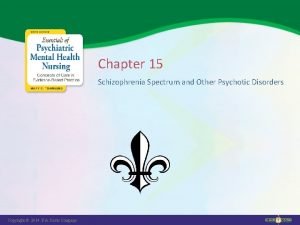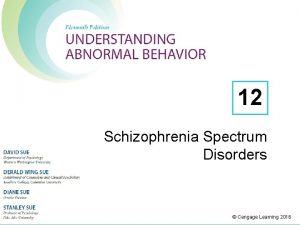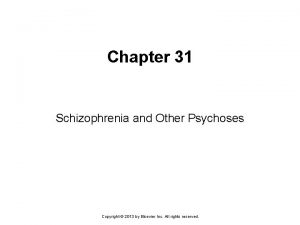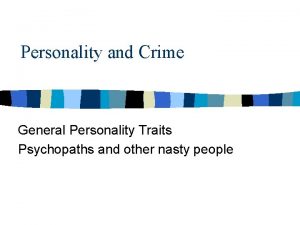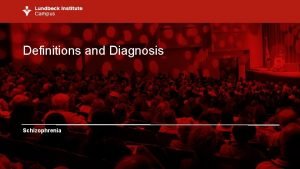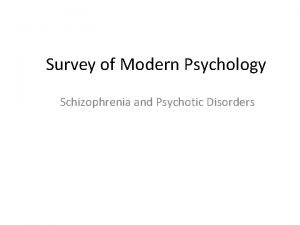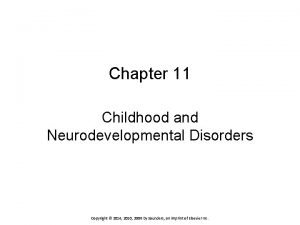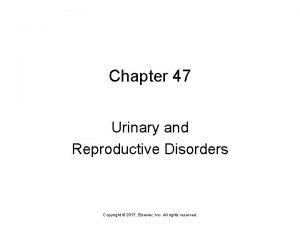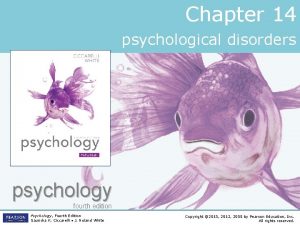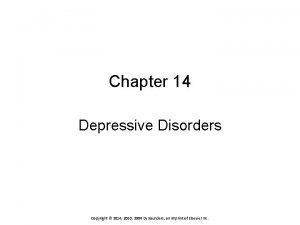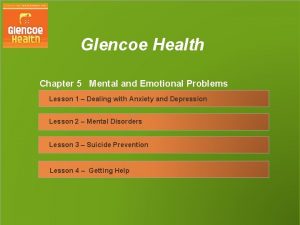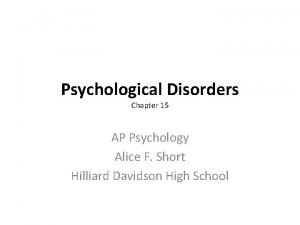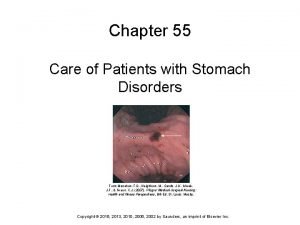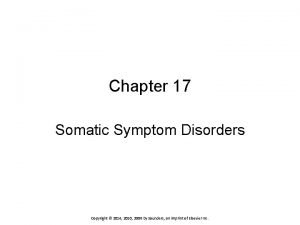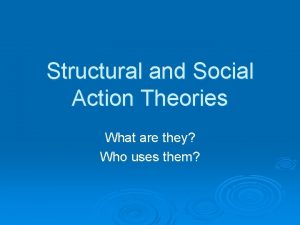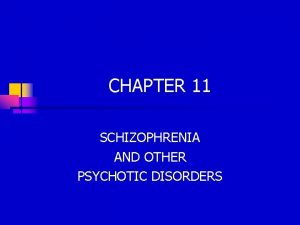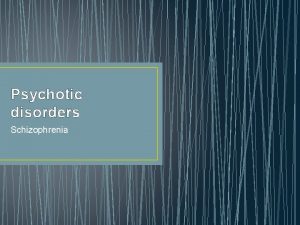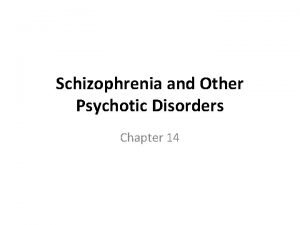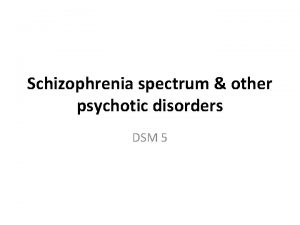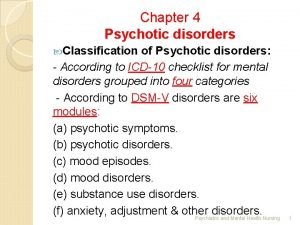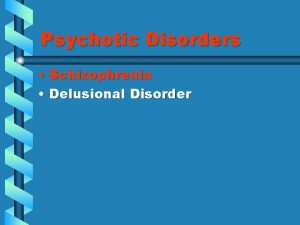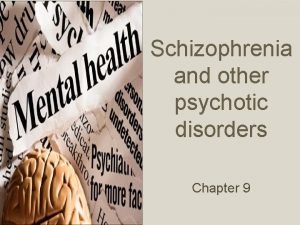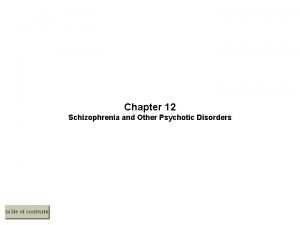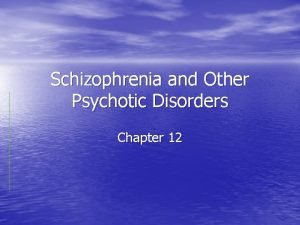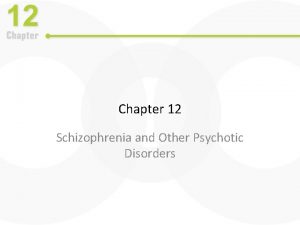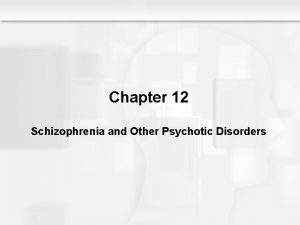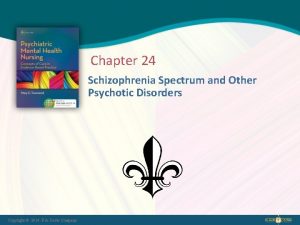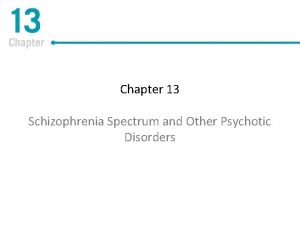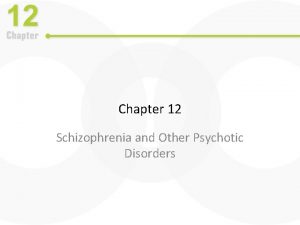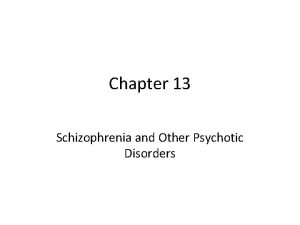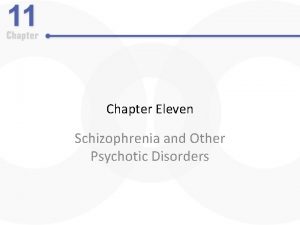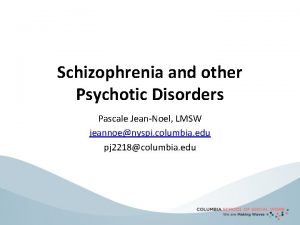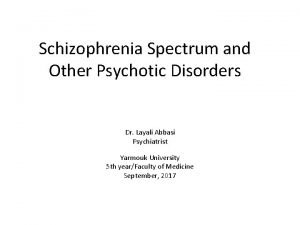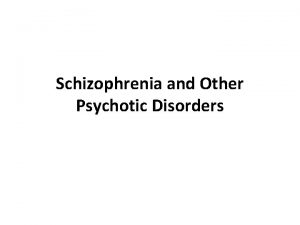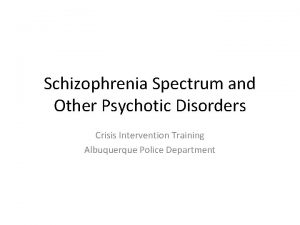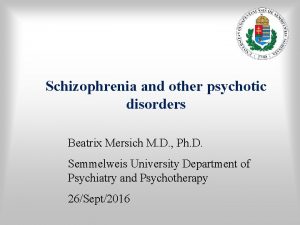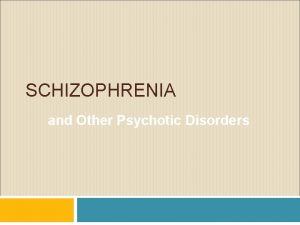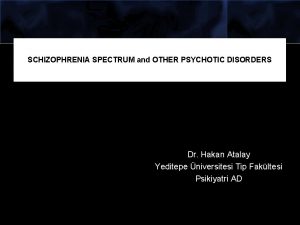Chapter 12 Schizophrenia and Other Psychotic Disorders Perspectives










































- Slides: 42

Chapter 12 Schizophrenia and Other Psychotic Disorders

Perspectives on Schizophrenia • Schizophrenia vs. psychosis – Psychosis – broad term (e. g. , hallucinations, delusions) – Schizophrenia – a type of psychosis • Psychosis and schizophrenia are heterogeneous – Disturbed thought, emotion, behavior

Nature of Schizophrenia and Psychosis: History and Current Thinking • Historical background – Emil Kraepelin – used the term dementia praecox • Subtypes of schizophrenia – Catatonia, hebephrenia and paranoia – Eugen Bleuler – introduced the term “schizophrenia” • “Splitting of the mind”

Nature of Schizophrenia and Psychosis: History and Current Thinking • Impact of early ideas on current thinking – Many of Kraeplin and Bleuler’s ideas are still with us – Understanding onset and course considered important • Psychotic behavior

Schizophrenia: The “Positive” Symptom Cluster • The positive symptoms – Active manifestations of abnormal behavior – Distortions of normal behavior • Delusions: The basic feature of madness – Gross misrepresentations of reality – Include delusions of grandeur or persecution

Schizophrenia: The “Positive” Symptom Cluster • Hallucinations – Experience of sensory events without environmental input – Can involve all senses – Findings from SPECT studies


Schizophrenia: The “Negative” Symptom Cluster • The negative symptoms – Absence or insufficiency of normal behavior • Spectrum of negative symptoms – Avolition (or apathy) – lack of initiation and persistence – Alogia – relative absence of speech – Anhedonia – lack of pleasure, or indifference – Affective flattening – little expressed emotion

Schizophrenia: The “Disorganized” Symptom Cluster • The disorganized symptoms – Severe and excess speech, behavior, and emotion • Nature of disorganized speech – Cognitive slippage – illogical and incoherent speech – Tangentiality – “going off on a tangent” – Loose associations – conversation in unrelated directions

Schizophrenia: The “Disorganized” Symptom Cluster • Nature of disorganized affect – Inappropriate emotional behavior • Nature of disorganized behavior – Includes a variety of unusual behaviors – Catatonia – spectrum

Subtypes of Schizophrenia: Paranoid and Disorganized • Paranoid type – Intact cognitive skills and affect – Do not show disorganized behavior – Hallucinations and delusions – grandeur or persecution – The best prognosis of all types of schizophrenia

Subtypes of Schizophrenia: Paranoid and Disorganized • Disorganized type – Marked disruptions in speech and behavior – Flat or inappropriate affect – Hallucinations and delusions – tend to be fragmented – Develops early, tends to be chronic, lacks remissions

Subtypes of Schizophrenia: Catatonic, Undifferentiated, and Residual • Catatonic type – Show unusual motor responses and odd mannerisms – Examples include echolalia and echopraxia – Tends to be severe and quite rare

Subtypes of Schizophrenia: Catatonic, Undifferentiated, and Residual • Undifferentiated type – Wastebasket category – Major symptoms of schizophrenia – Fail to meet criteria for another type • Residual type – One past episode of schizophrenia – Continue to display less extreme residual symptoms

Other Disorders with Psychotic Features: Schizophreniform and Schizoaffective Disorder • Schizophreniform disorder – Schizophrenic symptoms for a few months – Associated with good premorbid functioning – Most resume normal lives

Other Disorders with Psychotic Features: Schizophreniform and Schizoaffective Disorder • Schizoaffective disorder – Symptoms of schizophrenia and a mood disorder – Both disorders are independent of one another – Prognosis is similar for people with schizophrenia – Such persons do not tend to get better on their own

Other Disorders with Psychotic Features: Delusional Disorder • Delusional disorder – Delusions that are contrary to reality – Lack other positive and negative symptoms – Types of delusions include • • • Erotomanic Grandiose Jealous Persecutory Somatic – Extremely rare – Better prognosis than schizophrenia

Additional Disorders with Psychotic Features • Brief psychotic disorder – One or more positive symptoms of schizophrenia – Usually precipitated by extreme stress or trauma – Tends to remit on its own

Additional Disorders with Psychotic Features • Shared psychotic disorder – Delusions from one person manifest in another person – Little is known about this condition • Schizotypal personality disorder – May reflect a less severe form of schizophrenia

Schizophrenia: Statistics • Onset and prevalence of schizophrenia worldwide – About 0. 2% to 1. 5% (or about 1% population) – Often develops in early adulthood – Can emerge at any time

Schizophrenia: Statistics • Schizophrenia is generally chronic – Most suffer with moderate-to-severe lifetime impairment – Life expectancy is slightly less than average

Schizophrenia: Statistics • Schizophrenia affects males and females about equally – Females tend to have a better long-term prognosis – Onset differs between males and females • Genetic factors • Cultural factors


Causes of Schizophrenia: Findings From Genetic Research • Family studies – Inherit a tendency for schizophrenia, not forms of schizophrenia – Risk increases with genetic relatedness

Causes of Schizophrenia: Findings From Genetic Research • Twin studies – Monozygotic twins – Fraternal (dizygotic) twins – Adoption studies – risk for schizophrenia remains high • Cases where a biological parent has schizophrenia


Causes of Schizophrenia: Findings From Genetic Research • Offspring of twins • Summary of genetic research – Risk increases with genetic relatedness – Risk is transmitted independently of diagnosis


Search for Genetic and Behavioral Markers of Schizophrenia • Genetic markers: Linkage and association studies – Endophentypes – Schizophrenia is likely to involve multiple genes • Behavioral markers: Smooth-pursuit eye movement – The procedure – eye-tracking a moving object – Tracking deficits – schizophrenics and their relatives


Causes of Schizophrenia: Neurobiological Influences • The dopamine hypothesis – Drugs that increase dopamine (agonists) • Result in schizophrenic-like behavior – Drugs that decrease dopamine (antagonists) • Reduce schizophrenic-like behavior – Examples – neuroleptics, L-Dopa for Parkinson’s disease – Dopamine hypothesis is problematic and overly simplistic – Current theories – emphasize many neurotransmitters


Causes of Schizophrenia: Other Neurobiological Influences • Structural and functional abnormalities in the brain – Enlarged ventricles and reduced tissue volume – Hypofrontality – less active frontal lobes • A major dopamine pathway • Viral infections during early prenatal development – Findings are inconclusive

Causes of Schizophrenia: Other Neurobiological Influences • Conclusions about neurobiology and schizophrenia – Schizophrenia – diffuse neurobiological dysregulation – Structural and functional brain abnormalities • Not unique to schizophrenia


Causes of Schizophrenia: Psychological and Social Influences • The role of stress – May activate underlying vulnerability – May also increase risk of relapse • Family interactions – Families – show ineffective communication patterns – Schizophrenogenic mother – Double blind communication – High expressed emotion (EE)– associated with relapse

Causes of Schizophrenia: Psychological and Social Influences • The role of psychological factors – Exert only a minimal effect in producing schizophrenia


Medical Treatment of Schizophrenia • Historical precursors • Development of antipsychotic (neuroleptic) medications – Often the first line treatment for schizophrenia – Began in the 1950 s – Most reduce or eliminate positive symptoms – Acute and permanent side effects are common • Extrapyramidal and Parkinson’s-like side effects • Tardive dyskinesia • Compliance with medication is often a problem – Noncompliance with medication

Psychosocial Treatment of Schizophrenia • Historical precursors • Psychosocial approaches: Overview and goals – Behavioral (i. e. , token economies) on inpatient units – Community care programs – Social and living skills training – Behavioral family therapy – Vocational rehabilitation – Cultural considerations • Prevention

Summary of Schizophrenia and Psychotic Disorders • Schizophrenia – spectrum of dysfunctions – Affecting cognitive, emotional, and behavioral domains – Positive, negative, and disorganized symptom clusters

Summary of Schizophrenia and Psychotic Disorders • DSM-IV-TR – Five subtypes of schizophrenia – Includes other disorders with psychotic features • Several bio-psycho-social variables are involved • Successful treatment rarely includes complete recovery
 Anticholinergic rhyme
Anticholinergic rhyme Chapter 12 schizophrenia spectrum disorders
Chapter 12 schizophrenia spectrum disorders Chapter 12 schizophrenia spectrum disorders
Chapter 12 schizophrenia spectrum disorders Chapter 31 schizophrenia and other psychoses
Chapter 31 schizophrenia and other psychoses Neuroses
Neuroses Psychotic personality traits
Psychotic personality traits Psychotic disorder
Psychotic disorder Catatonia
Catatonia Bipolar and other related disorders
Bipolar and other related disorders Bipolar and other related disorders
Bipolar and other related disorders Nelson science perspectives 9 chapter 12
Nelson science perspectives 9 chapter 12 Retention hyperkeratosis dermnet
Retention hyperkeratosis dermnet Chapter 6 musculoskeletal system
Chapter 6 musculoskeletal system Chapter 46 digestive and endocrine disorders
Chapter 46 digestive and endocrine disorders Somatic symptom disorder
Somatic symptom disorder Chapter 29 endocrine and metabolic disorders
Chapter 29 endocrine and metabolic disorders Chapter 21 mental health diseases and disorders
Chapter 21 mental health diseases and disorders Chapter 18 eating and feeding disorders
Chapter 18 eating and feeding disorders Chapter 17 reproductive system diseases and disorders
Chapter 17 reproductive system diseases and disorders Chapter 15 nervous system diseases and disorders
Chapter 15 nervous system diseases and disorders Chapter 15 anxiety and obsessive-compulsive disorders
Chapter 15 anxiety and obsessive-compulsive disorders Chapter 11 childhood and neurodevelopmental disorders
Chapter 11 childhood and neurodevelopmental disorders Elsevier
Elsevier Chapter 10 nail disorders and diseases
Chapter 10 nail disorders and diseases What conditions do fungal organisms favor for growth
What conditions do fungal organisms favor for growth Cardiovascular system diseases and disorders chapter 8
Cardiovascular system diseases and disorders chapter 8 Milady chapter 8 skin disorders and diseases
Milady chapter 8 skin disorders and diseases Chapter 47 urinary and reproductive disorders
Chapter 47 urinary and reproductive disorders Chapter 11 lesson 2 body image and eating disorders
Chapter 11 lesson 2 body image and eating disorders 10 diseases of lymphatic system
10 diseases of lymphatic system Types of position
Types of position Chapter 18 psychological disorders review worksheet
Chapter 18 psychological disorders review worksheet Concept mapping chapter 11 genetic disorders
Concept mapping chapter 11 genetic disorders Chapter 18 psychological disorders
Chapter 18 psychological disorders Chapter 14 psychological disorders
Chapter 14 psychological disorders Chapter 14 depressive disorders
Chapter 14 depressive disorders Glencoe health chapter 9
Glencoe health chapter 9 Unit 2 mental and emotional health
Unit 2 mental and emotional health Chapter 14 psychological disorders
Chapter 14 psychological disorders Ap psychology chapter 15 psychological disorders
Ap psychology chapter 15 psychological disorders Chapter 55 care of patients with stomach disorders
Chapter 55 care of patients with stomach disorders Chapter 17 somatic symptom disorders
Chapter 17 somatic symptom disorders Differences between structural and action perspectives
Differences between structural and action perspectives
